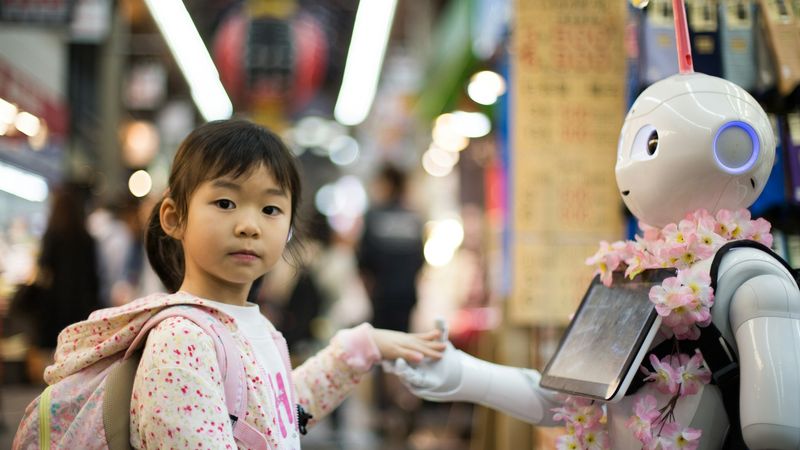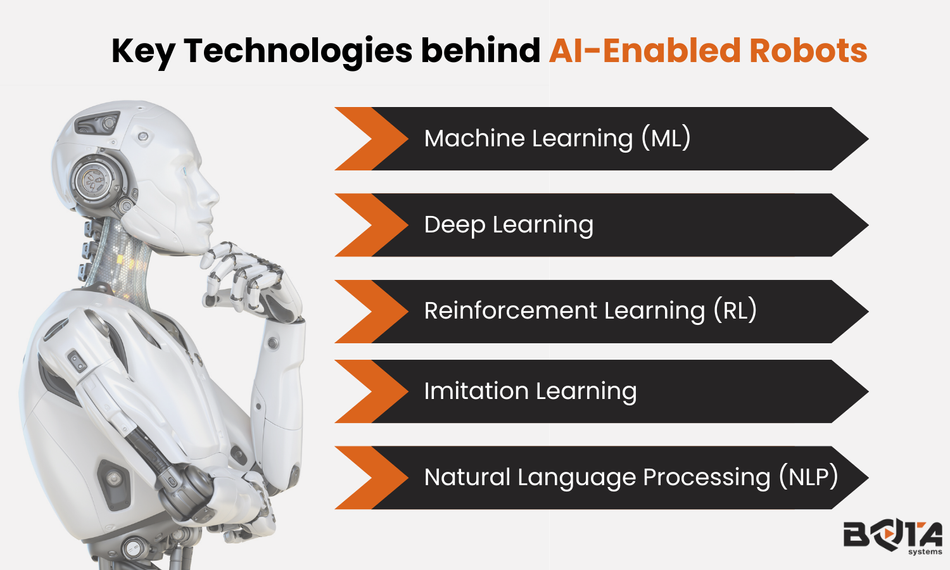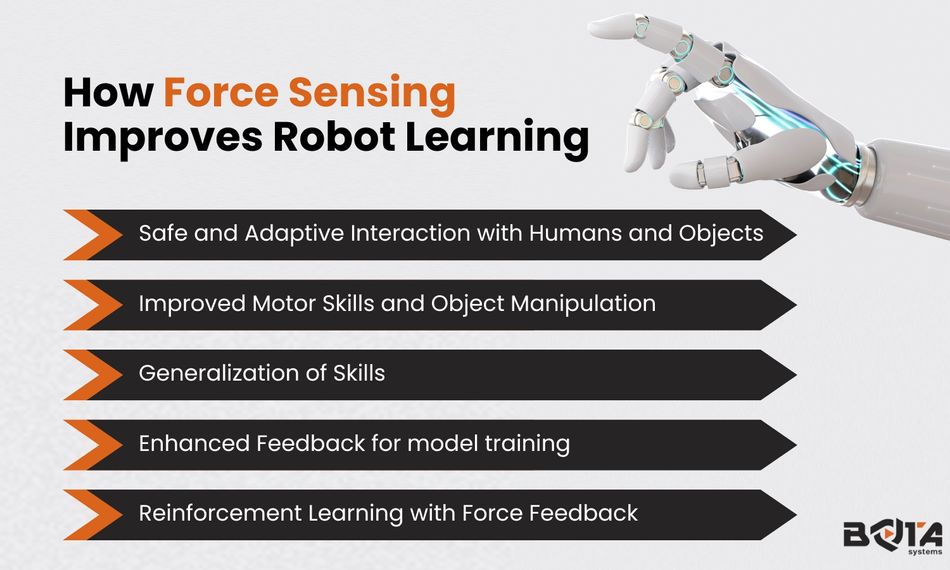AI-enabled robots and the importance of force sensing
Robots, combined with artificial intelligence (AI), are transforming industries such as manufacturing, healthcare, and research.

Photo by Andy Kelly on Unsplash
This article was first published on
www.botasys.comRobots operate under the laws of physics, but the complexity of physical interactions often makes it challenging to create precise mathematical models.
AI advancements now simplify this process by using historical data to develop models that help robots better understand and navigate their environments. Robots, combined with artificial intelligence (AI), are transforming industries such as manufacturing, healthcare, and research.
At the intersection of robotics and AI, AI-enabled robots promise more intuitive interaction methods, such as voice or text commands, eliminating the need for traditional programming.
This article explores the relationship between AI and robotics, focusing on the critical role of force sensing in AI model training and enhancing general robot capabilities.
Key Technologies behind AI-Enabled Robots
Integrating Artificial Intelligence (AI) into robotics has revolutionized how machines interact with their environments. Traditionally, robots operated based on pre-programmed instructions, performing repetitive tasks with high precision but lacking adaptability.
The introduction of AI, however, allows robots to learn from their environments, make decisions for more complex tasks, and improve their functionality over time. Let’s briefly describe the key AI technologies powering AI-enabled robots.
Machine Learning (ML)
Machine learning allows AI-enabled robots to recognize patterns, make predictions, and continuously improve performance through data-driven learning. For example, AI robots can identify an object from visual information like cameras.
Deep Learning
A subset of machine learning, deep learning uses neural networks to enable AI-powered robots to process vast amounts of data and learn complex tasks, such as image recognition and natural language processing.
Reinforcement Learning (RL)
Reinforcement learning is a trial-and-error-based learning approach, where AI-enabled robots learn optimal actions through rewards and penalties in dynamic environments. Usually, these are physical actions like walking or running and, to a lesser extent manipulating objects.
RL has shown impressive results in solving locomotion problems for walking robots. A key factor contributing to RL's success in robotics is that the trial-and-error process can be run multiple times in a simulated environment without the need to test on the actual robot.
However, RL faces limitations in contact-rich manipulation tasks, such as cleaning a dish or folding a cloth. This is mainly due to the fact that simulated physical contact models are unable to fully capture real-world dynamics.
Imitation Learning
Imitation learning is a technique in machine learning where the AI learns to perform tasks by observing and mimicking expert behavior, rather than being explicitly programmed. It is commonly used in robotics, where the goal is to teach robots to replicate human actions by watching demonstrations.
This approach enables the robot to acquire complex skills more naturally and intuitively, as it learns directly from examples rather than trial-and-error or predefined rules.
Imitation learning bridges the gap between human expertise and autonomous machine behavior, making it useful for applications where direct programming is difficult or impractical, such as in dynamic, and unstructured real-world environments.
In practice, the data required involve human demonstrations. A person on one end, teleoperates the robot through a “leader” device to command directly a “follower” robot. The “leader” makes sure that the “follower” achieves the tasks. The data are recorded and fed to the AI for training.
This is done multiple times until all, or a sufficient amount of “episodes” are recorded. These episodes include data from the robot sensing and actuating system.
Some other techniques involve demonstrations from videos where the behavior of humans is recorded. Force sensing in this case is impossible since the video includes only positional information.
Natural Language Processing (NLP)
Natural language processing enables robots to understand and respond to human language, enhancing communication and human-robot collaboration. It is usually required to identify and break down the commands given through human language so it can subsequently be fed into the robot’s decision-making unit, in which it can identify if the task is physically possible.
Now that we are familiar with the key AI technologies, let's move on to how these technologies aid in model training in robotics.
Model Training in Robotics
Model training in robotics refers to the process by which robots use data from their sensors to improve their behaviors, predict future outcomes, and make autonomous decisions.
Through AI technologies and algorithms described earlier, robots can develop models of their environment and their own physical capabilities, which enable them to perform tasks without constant human intervention.
For instance, a robot that learns how to navigate through a cluttered space can apply that knowledge to different environments with minimal reprogramming.
Humanoids, which are designed to resemble human forms, benefit significantly from these AI methods because they must operate in human-centric environments. Through continuous learning, they can adapt to new tasks such as carrying objects, interacting with people, or responding to dynamic changes in the environment.
Tesla’s humanoid robots are an excellent example, utilizing end-to-end AI to perform tasks based on real-time data rather than pre-set rules. These robots, initially teleoperated by humans for data collection, learn and refine their models through repeated demonstrations, improving their performance over time.
Tesla Optimus Gen 2 robotic humanoid
To learn and adapt, AI-powered robots require real-time data from the physical world. This is where 'force sensing' becomes essential. Let's explore how force sensing plays a pivotal role in the emerging era of artificial intelligence and robotics.
Force Sensing in AI for Humanoid Robots and more
Incorporating force sensing into model training helps AI models in humanoid robots understand the physical interactions between their bodies and their environment. By measuring the forces a robot encounters, force sensors contribute to building physical intelligence, enabling robots to perform complex tasks such as walking, grasping, and interacting safely with humans.
It is estimated that more than 30% of a robot's cost comes from 6D force-torque sensors, 1D force sensors, and 1D torque sensors.
Force sensing is the ability of a robot to perceive and measure the forces it encounters. This capability is especially important for any robot to perform complex tasks, such as walking, grasping objects, and interacting safely with humans and other objects in their environment.
Robots are machines governed by the laws of physics. The complexity of these physical principles can sometimes make it challenging to create deterministic mathematical models. However, advancements in AI make it easier to develop such models by analyzing historical data.
An object moves when a force is applied to it. Motion is the result of force. Just as text is essential for language models (LLMs), force is fundamental for robotic AI.
AI Humanoid robots face unique challenges due to their anthropomorphic design.
Force sensing is key in areas such as:
Balance and Stability
To walk or run like humans, humanoid robots need to balance dynamically on two legs. Force sensing in the feet and joints helps maintain stability and ensures that the robot can adjust its movements to uneven surfaces or unexpected shifts in balance.
Human-Robot Collaboration
In industrial settings or healthcare environments, robots often work side by side with humans. Force sensing enables these robots to detect human touch, collaborate in real-time, and react quickly to any unsafe conditions, making them safer and more reliable co-workers.
For instance, when assisting humans in healthcare or elderly care, humanoids must interact gently and safely. Force sensing ensures that the robot can gauge the right amount of pressure to apply when lifting or moving a patient, avoiding injury or discomfort.
Grasping Fragile Objects
An AI humanoid robot with force sensors can adjust its grip when holding delicate objects like glassware or electronics, ensuring they are not damaged due to excessive pressure.
Emulating Human Hand Movements
In complex tasks like typing or using tools, humanoid robots rely on force sensors to mimic the fine motor skills of human hands. This ability is especially important in industries like surgery or manufacturing, where precision is key.
Common Types of Force Sensors
Tactile Sensors: Mimicking the human sense of touch, these sensors allow humanoid robots to feel textures and detect when they are gripping or manipulating objects.
1 Axis Joint Torque Sensors: Used to measure rotational force, torque sensors help robots monitor the amount of force being applied by their joints during movements.
6 Axis Force Torque Sensors: These sensors measure three force components and three torque components. They are typically mounted at the wrists, behind the hands or grippers, and at the ankles in humanoid robots.
1 Axis Force Sensors: These sensors are mounted in the fixtures of the linear actuators that are used to move the limbs.
Pressure Sensors: These sensors measure applied pressure, enabling robots to determine the amount of force needed to hold or move an object without damaging it.
How Force Sensing Improves Robot Learning
Incorporating force sensing into AI humanoid robots allows for better interaction with the physical world and significantly enhances learning in the following ways:
Safe and Adaptive Interaction with Humans and Objects
Humanoid robots designed for social interaction and assistance need to handle objects safely and appropriately.
Force sensing ensures that the robot can adapt its movements to prevent excessive pressure on objects, making it possible to handle delicate items or interact safely with humans.
Improved Motor Skills and Object Manipulation
Just as humans learn to modulate force based on feedback from their muscles and nerves, robots require similar feedback mechanisms to learn effective motor skills.
Force sensors provide the critical input that enables robots to adjust their grip strength or adjust their balance while walking.
Generalization of Skills
Force sensing allows robots to generalize skills across different environments.
For example, a humanoid robot trained to carry a specific object can apply similar force-learning principles to carry other objects with different weights, shapes, and textures, making it adaptable in various situations.
Enhanced Feedback for model training
By integrating force sensing into the model training process, robots can fine-tune their motor functions with greater precision.
Force feedback helps robots to correct errors in real time, allowing them to adapt more quickly and efficiently when performing new or unpredictable tasks.
Reinforcement Learning with Force Feedback
Reinforcement learning (RL), which allows robots to learn by trial and error, is especially effective when combined with force sensing.
In this setup, force feedback provides real-time data on the robot's actions, offering a direct pathway to reward-based learning.
For instance, a robot tasked with grasping objects can use force sensing to adjust its grip strength, learning the optimal pressure for various materials and shapes.
Force sensing, coupled with reinforcement learning, can lead to improved efficiency in motor learning, enabling robots to adapt their behaviors in real-world scenarios without extensive pre-programming.
Real-World Applications of Force Sensing in AI-Powered Robots
Force sensing and AI integration are being employed across various industries to improve efficiency, safety, and precision. Some key examples include:
Robotic Surgery
AI robots equipped with force sensing are used in minimally invasive surgeries, where precision and delicate handling are critical.
Force feedback allows surgeons to perform highly accurate procedures by providing real-time data on the pressure applied during surgery. The complicated mechanics of the tissues that cannot be modeled, are measured by the force sensing.
Rehabilitation Robotics
In rehabilitation, AI-powered robots with force sensing assist patients in regaining motor skills after injuries. These robots adjust their resistance and support based on the patient's movements, providing personalized therapy.
Automated Assembly Lines
Open-TeleVision robot sorting cans
Force sensing is crucial in manufacturing, where AI robots handle delicate components in industries such as electronics or automotive assembly. These robots can adjust their force in real time, ensuring parts are handled with care.
AI-Driven Service Robots
In customer-facing roles, service robots use force sensors to handle objects and interact safely with humans, whether serving food, delivering packages, or providing customer assistance in retail environments.
Challenges in Force Sensing and AI Integration
While the integration of force sensing and AI presents numerous opportunities, there are challenges that need to be addressed:
Sensor Accuracy
The accuracy of force sensors is critical for precise robot operations. Ensuring that sensors can detect subtle changes in pressure and resistance while remaining reliable over time, is a significant challenge.
Processing Large Data Volumes
Force sensors generate vast amounts of real-time data. AI algorithms must process this data efficiently to make timely decisions, which can be computationally demanding.
Incorporating Feedback into Decision-Making
Developing AI algorithms that can effectively incorporate force feedback into their decision-making processes is complex. The challenge lies in ensuring that robots can adjust their actions in a manner that is both safe and effective.
Current and Future Trends in AI and Force Sensing for Robots
The field of AI-powered robotics is evolving rapidly, with new innovations on the horizon that are likely to redefine what humanoid robots can do.
Force sensing technology has been miniaturized and made lightweight, enabling easy integration of a sense of touch into all robots.
Enhanced Tactile Feedback Systems
Researchers are exploring advanced materials and sensors that mimic human skin, giving robots a more nuanced sense of touch.
These developments will enable robots to interact with objects with the same sensitivity that human hands possess.
Multi-Modal Sensing and Data Fusion
The future of robot learning will involve the fusion of multiple sensing modalities (e.g., visual, auditory, and force sensing) to provide a more comprehensive understanding of the environment.
This would enhance the robot's ability to navigate complex, unstructured environments and perform a broader range of tasks.
Robotic Assistants in Daily Life
As AI and force sensing improve, humanoid robots may become household companions and assistants, helping with daily chores, caring for elderly individuals, or assisting people with disabilities.
Force sensing will play a pivotal role in ensuring that these robots interact safely and effectively with their human counterparts.
Advances in AI Model Training
The use of force sensing in model training will lead to more generalized robot learning approaches, allowing robots to learn multiple tasks from fewer examples and better adapt to novel situations.
Bota Systems: Enhancing Robotic Precision and Adaptability
Bota Systems is a leading provider of high-performance force torque sensors that are designed to enhance the capabilities of robots in various applications.
These sensors enable robots to detect and respond to physical interactions with precision, making them ideal for tasks that require fine motor control, such as assembly, manipulation, and human-robot collaboration.
An example of their innovative technology is the MiniONE sensor, a compact, lightweight 6-axis force/torque sensor designed for small robotic arms and drones. It provides high accuracy in measuring forces and torques across all axes, making it suitable for delicate tasks like polishing, deburring, or robotic surgery.
Bota Systems is a market leader with state of art force sensing technology. With Bota Systems' cutting-edge force torque sensors, robots can achieve greater precision, adaptability, and safety, paving the way for more advanced automation across a wide range of industries.

